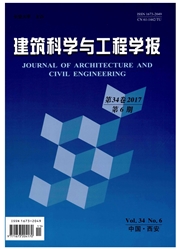

 中文摘要:
中文摘要:
采用虚拟激励法推导出基于粘性阻尼假定和任意平稳随机地震动的复振型完全平方组合(CCQC)法原始表达式(0CCQC)及其传统简化表达式TCCQC,并与基于复阻尼假定的平稳随机振动分析结果进行对比。结果表明:高厚比较大的结构TCCQC式计算结果偏小较多,而0CCQC式计算结果更加接近,比TCCQC式要更为合理;基于粘性阻尼假定时,阻尼矩阵与复模态分析结果之间相互影响,反应谱CCQC法计算结果不惟一,合理性不易被判定;若粘性阻尼矩阵构造得当,反应谱CCQC法计算结果与基于复阻尼假定的平稳随机振动分析结果接近,但要构造恰当的粘性阻尼矩阵费时费力;结构设置有粘性阻尼类型机械阻尼器时宜采用基于粘性阻尼假定的反应谱CCQC法,否则采用基于复阻尼假定的反应谱CCQC法更加便捷。
 英文摘要:
英文摘要:
A pseudo-excitation method was used to deduce a new formula of original complex complete quadratic combination (OCCQC) method and its simplified form according to traditionally simplified complex complete quadratic combination (TCCQC). The results of TCCQC were compared with the results of stationary random vibration analysis based on complex damping assumption. The results show that the results of TCCQC of structures which have greater height to thickness ratio are much less, while the calculation results of OCCQC are in good agreement, which shows that OCCQC is more rational than TCCQC. Damping matrix based on viscous damping assumption interacts with results of complex modal analysis, so calculation results of response spectrum CCQC method are not unique and the rationality of results is difficult to be determined. If viscous damping matrix is properly constructed, calculation results of the response spectrum CCQC method based on viscous damping assumption will agree well with that of stationary random vibration analysis based on complex damping assumption, but constructing proper viscous damping matrix is a time-consuming and hard work. The response spectrum CCQC method based on viscous damping assumption is suggested only for structures where viscous damping type mechanical dampers are placed, otherwise the response spectrum CCQC method based on complex damping assumption is more convenient and efficient.
 同期刊论文项目
同期刊论文项目
 同项目期刊论文
同项目期刊论文
 期刊信息
期刊信息
